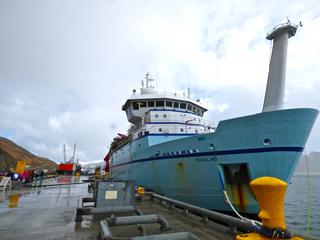R/V Sikuliaq Meets Unalaska On Route to Ice Trials

Thursday, March 19 2015
Unalaskans are used to research vessels big and small tying up at their city dock. But they’ve never seen anything quite like the Sikuliaq.
The University of Alaska and National Science Foundation’s new ice-capable research ship stopped in the port of Dutch Harbor this week, on its way to a test drive in sea ice up north.
The spacious bridge of the Sikuliaq looks like something out of science fiction. It’s packed with navigational touchscreens and high-tech thrusters, with a sleek black and blue color scheme.
But for the dozens of Unalaska kids on board, the floor-to-ceiling view is the biggest draw.
Alysha Richardson: She likes the windows. Did you see the water?
Two-year-old Lennyn Richardson has been toddling all around the ship with her mom, Alysha, and her brand-new baby brother Asher. This is his first research vessel, but Lennyn is an "old pro" -- Alysha says they’ve toured the Fish & Wildlife ship Tiglax in Unalaska before. It’s only about half the size of the Sikuliaq.
"I think that’s the biggest difference," Richardson says. "It seems like there’s a lot more going on. Could get a lot more specialized than maybe what they did over there [on the Tiglax]."

Lennyn Richardson tries out the captain's chair on the bridge of the R/V Sikuliaq while mom Alysha, dad Brett and Capt. Mike Hoshlyk (far right) look on. (Annie Ropeik/KUCB)
The Sikuliaq was specially designed to support all kinds of research -- from fisheries to climatology to microbiology -- and to do it in up to a meter of sea ice. The ship’s got wet labs, dry labs, computer labs, cranes and space for more than 40 crew and scientists.
Middle school teacher Amber Wood has brought some of her students on board during Wednesday's "open-ship" tour. Some of the class has been on boats like the wildlife trooper patrol vessel Stimson or the Coast Guard icebreaker Healy in Unalaska before. But this ship -- and the students' tour -- is a lot more science-focused.
"So many of them are affiliated in some way to the fishing industry -- like whether their parents work in the different processing plants, or work on a boat themselves, or have small private vessels," Wood says of her class. "So it’s pretty cool for them to go see the next level up -- the bigger level up."
The Sikuliaq is on its way to test out all those next-level instruments and capabilities on the ice. Chief scientist Carin Ashjian of the Woods Hole Oceanographic Institution says they don’t have a lot of set plans for actual research during this trip -- though you never what might come up.
"One way you could think of it is science of opportunity," Ashjian says.
Ashjian is no stranger to Unalaska -- she and many colleagues have sailed through before on ships like the icebreaker Healy, on the same kind of research missions the Sikuliaq is designed for.
"She’s got a really great suite of sophisticated sensors, a really big back deck, much bigger than the Healy’s," Ashjian says of the Sikuliaq. Ideally, she says the Healy would still do research in thicker winter ice up north -- and the Sikuliaq would cover thinner, seasonal ice, which it’s named for in Inupiaq.
The vessel is homeported in Seward, but the deep-water Port of Dutch Harbor is a closer fuel stop to the Arctic, and it’s ice-free all year. That means residents could see the Sikuliaq a lot in the future.
Ashjian says she always likes stopping in Unalaska, whether she’s introducing a ship or the research it’s doing.
"I’ve really started talking to the community in the late 2000s, and they’ve been interested in climate change and what’s going on with the weather and the environment since I started coming up here," she says. "It’s always fun to come to talk in Dutch [Harbor] because people ask great questions."
The Sikuliaq will spend the next three weeks in the northern Bering Sea. Then they’ll head home, bringing the results of their maiden sea ice voyage back through Unalaska on the way.
You can stay updated on the Sikuliaq's journey at sikuliaq.alaska.edu.



